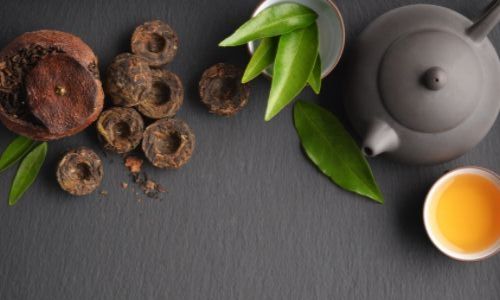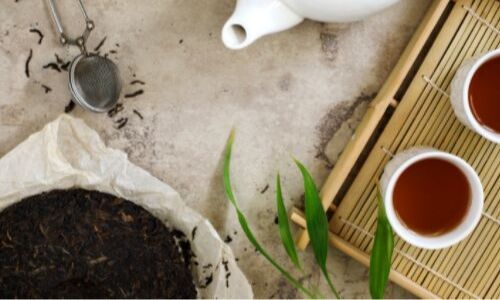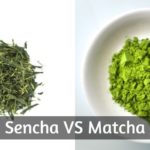In your quest to know just everything there is to know about tea, you also need to know everything about Pu'erh tea.
After all, Pu'erh is an ancient and well-respected Chinese tea, and it fetches a high price on the market.
So let's start with the beginner's guide to Pu'erh tea, and know all there is to know about this beautiful tea.
Table of Contents
1. What is Pu'erh tea ?
Pu'erh tea is a traditional Chinese tea, dating back to the 7th century. It's a type of the that is produced by storing and fermenting the tea leaves, pressing them into a sort of cake or brisk shape.
The bricks/cakes are left to further ferment in warm, damp cellars for months or years, so they can develop their flavors. After they've been developed, they are then stores in cool, dry cellars which will mellow out the flavor even more.
In a way, Pu'erh tea resembles wine, in that it's an aged product and the more you age it the better and more sophisticated it becomes.
It also resembles pickles (in brine), since it relies on naturally occurring bacteria to ferment/process the tea and thus change its taste. It does not taste like pickles, don't worry.
Pu'erh tea isn't easy to find on the market, and you'll have to check with the Chinese vendors since only they will have it in stock. You can get either full bricks/cakes, or loose leaf servings broken from the main brick.
2. Does Pu'erh tea have caffeine ?
Yes, Pu'erh tea does have some caffeine. It's made from the same tea plant as black tea and green tea (Camellia sinensis), and the plant itself the caffeine source.
Exactly how much caffeine is present in Pu'erh isn't clear, since it depends heavily on how the tea was processed.
And each tea cake/brick is processed slightly differently, according to each tea master.
Another thing, or a more specific thing, that determines the caffeine content is how young the tea leaves were when they were picked.
The younger the leaves, the more caffeine.
This means that a green Pu'erh will usually contain more caffeine than black varieties. Even so, older Pu'erh cakes will have less caffeine than the younger ones, since the whole developing and aging process slowly breaks down the caffeine in tea over the years.
If you want a rough estimate, tea in general is accepted to be somewhere around 40 mg caffeine/8 oz of prepared drink. That's half an espresso, and 3-4 times less than filter coffee.
Exactly how much a Pu'erh has, there is no way of knowing unless you personally run some tests on the brew. But if you'd like to get less caffeine from your tea, you should know that the first brew will always have the largest amount of caffeine.
If you brew the same leaves a second time, you will get less caffeine and a subtler aroma. This is possible both with the Western and the Gong Fu method as well.
3. Where does Pu'erh tea come from ?
Pu'erh tea is a Chinese tea, so it comes from China. To be more specific it comes form the Yunnan province, since no other tea, grown anywhere else, is allowed to be named or made into Pu'erh tea.
This is why you'll probably only find this tea in the hands of Chinese vendors, since the leaves are rarely outsourced and then processed somewhere else, like in a different country or a different continent.
And according to the Chinese custom, Pu'erh tea is made either green(sheng) or black(shou). But it's not the usual black tea we know in the West.
Their black/shou is different from the Western black tea we all know. Western black tea is known as red tea in China, and this produces some confusion when dealing with some vendors.
The Chinese black Pu'erh produces a truly black color, almost identical to coffee, while Western black tea produces a dark red brew, and the Chinese named it red tea.
Come to think of it, if anyone knows which tea is which it's definitely the guys who started all of it. But naming conventions stick, so in the West we know it by another name.
In short, keep in mind that you might have a little trouble discerning which tea is which.
The Chinese black/shou Pu'erh contains leaves that were fermented extra-fast, and haven't necessarily been made Western black tea leaves beforehand. So they're not even close to Western black tea leaves.
Pu'erh tea - origins and history (short)
There is an anecdote, or short story, that most people know about the origin of Pu'erh tea. For a while I believed it as well, since it has a grain of truth to it. It started back when the Silk Road was a thing, and the Chinese were heavily trading in tea and spices.
During the long trek from China to Europe, the teas (usually green) would compress in their packaging, since this trip took anywhere from several months to two years, depending on where you were going.
The compressed tea became fermented because of the temperature fluctuations and the long time spent on in the package. Upon opening the packages the merchants saw that the tea had changed, and when they brewed it they noticed it was a very elegant, and aged flavor.
Now that's the story, but as far as we can get to any truth Pu'erh tea came about after the tea industry (again, this was in the early centuries) needed to transport teas in a very compact way, so they could carry more and store them easily.
Specifically, they needed to get large amount of tea to Tibet, in exchange for horses. So they packed the tea as closely and airtight as they could at the time.
And the teas did ferment when stored this way, and once someone noticed that, the process was refined and shortly after that it became the Emperor's favorite tea.
It was made better and better, and was seen as a way to preserve one's life, health, and thus reign. After a while it became available tot he common people as well, which is when it became even more popular.
Fast forward several centuries and the British and French are competing with the Chinese for tea monopoly. This made trade and export easier, and Pu'erh became known in Europe as well.
4. How is Pu'erh tea made ?
When making Pu'erh tea, you need to be careful in regard to several factors.
First, the tea leaves are harvested, like for any other tea. But these can be:
- wild tea plant leaves, which are usually bigger and rather silver in color
- leaves from ancient tea plants that still stand (think 1000 years)
- fairly young plants (a couple of decades) that give smaller but more densely packed leaves
Each leaf and plant type is appreciated in its own way, and the ancient ones are pretty rare.
After the leaves are picked, they're bruised and shaken a bit so they get their fermentation (oxidation) process started, very similar to the oolong tea process.
More or less bruising/oxidation leads to different levels of flavor, which the tea master will guide and help mature in the coming months and years.
Once the leaves are bruised and have started to oxidize, they are are left to dry out. Drying them slows the oxidation process, and once the tea master is happy with the level the leaves have reached, he will steam them.
Steaming is a form of locking in the oxidation, and allowing no more to take place. This is why it matter when the leaves are steamed, since it affects the final taste.
Once that's done, the leaves are finally stored in the shapes that they usually come in (like a brick, or care, others yet like a mushroom top).
If black/shou Pu'erh tea is being made, the leaves are left to oxidize in a pile before drying them. This darkens the leaves and accelerated the oxidation. The green variety is laid out in a single thin layer.
The cakes/bricks are of differing shapes and sizes, and this affects the final taste in a small manner.
Once the cakes have been made, they are left in warm, moist cellars to help develop bacteria, and begin the fermentation process. This process is very strictly controlled, since it's a very delicate balance between harmful and delicious.
This goes on for several months, and after the fermentation has reached a point the tea master approves of, he will move the Pu'erh cakes into dry, cool cellars that will slow down the fermentation, and simply age them.
The cakes will stay there for as long as 50 years (the longest we know of), but most need about 7 years to fully develop the flavors.
Some Pu'erh, especially the one meant for restaurants and cafes aren't packed into cakes, but rather kept in their loose leaf form.
This means they are rolled after steaming, and given the fact that full leaves are exposed to more air than packed leaves, they age much quicker. After they've been aged to the point the tea master wants them to be, they are then packaged and sent to the restaurants.
5. What does Pu'erh tea taste like ?
Pu'erh tea can taste like many things, since it's a versatile tea, and it's also got two distinct categories (black and green).
This means that you will find honey, flowery notes and maybe a bit of nuttiness, and this is mostly true for the green varieties. They're usually golden or slightly amber in color when brewed. Sometimes you will find they have a fruity tone, like raisin or plum.
Other varieties, especially the black ones, lean more towards a more buttery, nutty, malty flavor. Can sometimes get a bit earthy, and edging into chocolate a bit.
The brews from black Pu'erh are usually very dark amber, chestnut, sometimes almost black.
A good Pu'erh tea you'll love
If you've never had a Pu'erh tea then you're definitely going to want to get a good one for your first.
For example this one by Runtu is a black/shou Pu'erh tea, and comes in the form of a tea cake wrapped in cotton paper and bamboo skin.
It's a 2017 tea, so it's been aged and it's got a dark red brew, very fruity and a bit flowery.
It's actually one of the few teas tat comes with the province and place of origin provided (Lincang, Yunnan province) and weighs 12 ounces.
You can find the listing on Amazon here, and read the reviews as well.
6. How to brew Pu'erh tea
When brewing Pu'erh tea you're meant o thoroughly enjoy the craft of the tea master. This means that it's a tea that will show you several layers of flavor, and you can definitely reuse the tea leaves.
The best way to do so is to use the Gong Fu method, which is to fill a Gaiwan with a few tea leaves, add hot water (80 C/176 F), and let brew for 10-15 seconds.
The pour the contents out, and it will only be a couple of ounces of brew. Once you're done drinking that brew, fill the Gaiwan again with water - you're reusing the first leaves - hot water, let sit for 15 seconds, and then pour into cups.
Repeat this step as much as the tea leaves will allow you. Most Pu'erh will allow you 4-5 brews, but some will even get to 8 or 9. Again, this all depends on the tea master's craft.
Each tea cake has a specific amount (grams usually) you need to add to the Gaiwan on order to get a good brew.
A simple, beautiful Gaiwan for Pu'erh
This Gaiwan from Li Da Tea House is a not only beautiful, but it also comes with both the pot and the cup.
It's a nice porcelain Gaiwan, and it can hold up to 90 ml/3 oz of liquid, while the cup will hold 50 ml/2 oz.
Keep in mind that this is a fairly small item, since the whole meaning of the Gong Fu tea drinking is to slow down and really enjoy the tea, and appreciate all the steps it had to take in order to get to you.
This means that being mindful while you pour your tea in several infusions will help you relax and really enjoy your hour of quiet.
You can check the listing on Amazon here, and read the reviews as well.
If the Gong Fu method is too much for you - it can take some time, that's true - then the Western style of preparing tea is going to do just fine as a substitute.
What you need for this is a good infuser, and again hot water at 80 C/176 F.
The usual brewing time for Pu'erh is 2-3 minutes, usually the lighter the tea (like green) the less time it needs.
However I recommend you use a timer in the first few tries, and sample the tea every half minutes, so you know which steeping time you like best.
Then, after your little experiment is done, you'll always know how much you like to brew any type of Pu'erh.
You'll need a good infuser, and a timer
The best way to infuse tea, as far as I've seen, is to just prepare the tea in the mug/cup to begin with.
Not only is it simpler, but you get no loss of flavor or tea.
For example this porcelain mug comes complete with an infuser (metal) and a ceramic top to help you tea brew without losing its temperature.
When you're done brewing, simply take the top off, turn it upside down, take out the infuser/strainer, and place it on the upturned lid.
It's a large cup, it can hold 15 oz of liquid but that does not allow for the strainer, so remember that when you brew your tea.
It comes in several colors and patterns, and you can get whichever you want. I for one like this pink one, so this is what I'm showing you.
You can check the listing on Amazon here, and read the reviews as well.
Once you've got a good mug and infuser and have everything you need, get a timer. The one on your phone is good, or in a worst case scenario even one of those kitchen timers will do.
Set is to 2 minutes, brew, and see if you need less than 2 minutes or want to let it brew a little more.
7. How to store an entire Pu'erh tea cake
When storing Pu'erh tea cake, you're not meant to store it like other teas. Storing Pu'erh in tea caddies with no airflow is disastrous if you keep it like that for years on end, and will lead to the tea actually going bad.
No, for a Pu'erh you need a wholly different storing method. Remember that this is a tea that spend several years in a dark, cool, dry cellar to mature.
So that's what you're going to need to imitate. There are several items that help you store Pu'erh tea, but I think this one is your best bet.
Pu'erh cake storage box
Most of the time the best way to store a big Pu'erh cake is leave it in its original packing paper, and store it like so in a wooden, or hard cardboard box.
What I have here is a wooden box, which is actually a very slim drawer. Which means you can just place the cake inside the box, and close it, and then sore said box in a safe corner of the house.
The box has an air circulation system by means if an intricate laser cut pattern on the top of the box, which is essential since the Pu'erh needs to breathe. The ornamental part adds more charm to something practical.
You can check the listing on Amazon here, and read the reviews as well.
After storing your Pu'erh in the box, you will need to leave said box in s dark, cool, and dry a place as you can find in your home. If your basement is dry, then you can definitely store it there.
If not, then any dark, cool, dry corner of the house will do, ad long as no children or pets can easily reach the tea cake.
Whenever you'd like some of the Pu'erh it's best to cut or break off a larger chunk and break that up with your fingers. You can then store those leaves in a simple tea caddy for up to half a year.
Do keep in mind that when you cut or break a large chunk of the tea, you're exposing more of it to the air. And this means it will ferment/develop faster, so if you're not planning on drinking the entire tea cake within 5 years, then you'd better leave it whole.
Final thoughts
Pu'erh is a really special tea, and you're going to enjoy it for sure. It's just not that common, especially when you compare it to green or black tea, but it's got a flavors of its own.
If you want to know more about coffee or tea, feel free to check the related articles below. Who knows what else you might find ?











